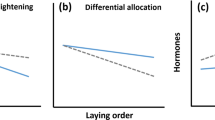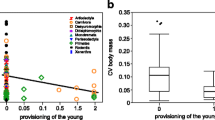Summary
Energy expenditure of adult Pied Kingfishers was measured with doubly-labeled water. Results were related to reproductive success of parents aided and unaided by helpers. Energetically stressed parents in a colony with poor food supply accepted potential helpers more often than unstressed birds in another colony where food was easily available. This treatment of helpers was reversed in both colonies through experimental manipulation of clutch size and hence energetic stress. Results are discussed in relation to the costs and benefits that helpers incur on the parents' fitness.
Similar content being viewed by others

References
Aschoff J, Pohl H (1970) Der Ruheumsatz von Vögeln als Funktion der Tageszeit und Körpergröße. J Ornithol 111:38–47
Brown JL (1974) Alternate routes to sociality in jays with a theory for the evolution of altruism and communal breeding. Am Zool 14:63–80
Brown JL (1982) Optimal group size in territorial animals. J Theor Biol 95:793–810
Brown JL (1984) The evolution of helping behavior — an ontogenetic and comparative perspective. In: Gollin ES (ed) The evolution of adaptive skills: comparative and ontogenic approaches. Academic, New York
Brown JL, Dow DD, Brown ER, Brown SD (1978) Effects of helpers on feeding of nestlings in the grey-crowned babbler (Pomatostomus temporalis). Behav Ecol Sociobiol 4:43–59
Bryant DM, Westerterp KR (1983) Short-term variability in energy turnover by breeding house martins (Delichon urbica): a study using double-labeled water. J Anim Ecol 52:525–543
Caraco T (1979) Time budgeting and group size: a test of theory. Ecology 60:618–627
Caraco T, Martindale S, Pulliam HR (1980) Avian time budgets and distance to cover. Auk 97:872–874
Davies NB, Houston AI (1981) Owners and satellites: the economics of territory defence in the pied wagtail, Motacilla alba. J Anim Ecol 50:157–180
Douthwaite RJ (1976) Fishing techniques and foods of the Pied Kingfisher at Lake Victoria in Uganda. Ostrich 47:153–160
Douthwaite RJ, Reyer HU, Dunn EK (in press) The Pied Kingfisher (Ceryle rudis). In: Cramp S, Simmons KEL (eds) Handbook of the birds of Europe, the Middle East and North Africa. Oxford University Press, Oxford
Drent R, Daan S (1980) The prudent parent: energetic adjustments in avian breeding. Ardea 68:225–252
Drent R, Ebbinge, B, Weijand B (1978/1979) Balancing the energy budgets of artic breeding geese throughout the annual cycle: a progress report. Verh Ornithol Ges Bayern 23:239–264
Emlen ST (1982) The evolution of helping. I. An ecological constraint model. Am Nat 119:29–39
Emlen ST (1984) Cooperative breeding in birds and mammals. In: Krebs JR, Davies NB (eds) Behavioral ecology: an evolutionary approach, 2nd edn. Blackwell, Oxford, pp 305–339
Ewald PW, Carpenter FL (1978) Territorial responses to energy manipulations in the Anna hummingbird. Oecologia (Berl) 31:277–292
Gaston AJ (1978) The evolution of group territorial behavior and cooperative breeding. Am Nat 112:1091–1100
Gill FB, Wolf LL (1975) Economics of feeding territoriality in the goldenwinged sunbird. Ecology 56:333–345
Jarman P (1974) The social organization of antelopes in relation to their ecology. Behaviour 48:215–267
Karasov WH, Anderson RA (1984) Interhabitat differences in energy acquisition and expenditure in a lizard. Ecology 65:235–247
Koenig WD, Pitelka FA (1981) Ecological factors and kin selection in the evolution of cooperative breeding in birds. In: Alexander RD, Tinkle DW (eds) Natural selection and social behavior: recent research and new theory. Chiron, New York, pp 261–280
Krebs JR (1974) Colonial nesting and social feeding as strategies for exploiting food resources in the great blue heron (Ardea herodias). Behaviour 51:99–134
Krebs JR, Cowie RJ (1976) Foraging strategies in birds. Ardea 64:98–116
Lifson N, McLintock R (1966) Theory and use of turnover rates of body water for measuring energy and material balance. J Theor Biol 12:46–74
Lott DF (1984) Intraspecific variation in social systems of wild vertebrates. Behaviour 88:266–325
Norberg RA (1981) Temporary weight decrease in breeding birds may result in more fledged young. Am Nat 118:838–850
Nur N (1984) The consequences of brood size for breeding blue tits. I. Adult survival, weight change and the costs of reproduction. J Anim Ecol 53:479–496
Orians GH, Orians CE, Orians KJ (1977) Helpers at the nest in some Argentine blackbirds. In: Stonhouse B, Perrins C (eds) Evolutionary ecology. MacMillian, London, pp 137–151
Pulliam HR, Anderson KA, Nisztal A, Moore N (1974) Temperature-dependent social behaviour in juncos. Ibis 116:360–364
Reyer HU (1980) Flexible helper structure as an ecological adaptation in the Pied Kingfisher (Ceryle rudis). Behav Ecol Socibiol 6:219–227
Reyer HU (1984) Investment and relatedness: a cost/benefit analysis of breeding and helping in the Pied Kingfisher (Ceryle rudis). Anim Behav 32:1163–1178
Riedman ML (1982) The evolution of alloparental care and adoption in mammals and birds. Q Rev Biol 57:405–435
Sokal RR, Rohlf FJ (1969) Biometry. Freeman, San Francisco
Stallcup JA, Woolfenden GE (1978) Family status and contributions to breeding by Florida scrub jays. Anim Behav 26:1114–1156
Vehrencamp SL (1979) The roles of individual, kin, and group selection in the evolution of sociality. In: Marler, P, Vandenbergh JG (eds) Handbook of behavioral neurobiology, social behavior and communication, vol 3. Plenum, New York, pp 351–394
Walsberg GE (1983) Avian ecological energetics. In: Farner DS, King JR (eds) Avian biology, vol 7. Academic, New York
Westerterp KR, Bryant DM (1984) Energetics of free existence in swallows and martins (Hirudinidae) during breeding: A comparative study using doubly-labeled water. Oecologia (Berl) 62:376–381
Westerterp K, Drent R (in press) Energetic costs and energysaving mechanisms in parental care of free-living passerine birds as determined by the D2 18O-method. Proc IVIII Congr Int Ornithol, Moscow 1982
Whitfield AK, Blaber JM (1978) Feeding ecology of piscivorous birds at St. Lucia. Part 1. Diving birds. Ostrich 49:185–198
Author information
Authors and Affiliations
Rights and permissions
About this article
Cite this article
Reyer, HU., Westerterp, K. Parental energy expenditure: a proximate cause of helper recruitment in the pied kingfisher (Ceryle rudis). Behav Ecol Sociobiol 17, 363–369 (1985). https://doi.org/10.1007/BF00293214
Received:
Accepted:
Issue Date:
DOI: https://doi.org/10.1007/BF00293214



